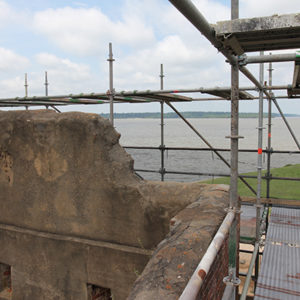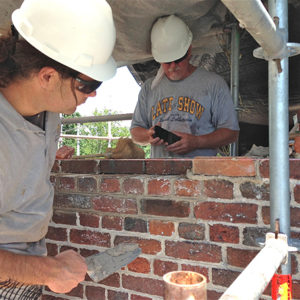About 5,000 bricks made by craftsmen at the Colonial Williamsburg Foundation are going into Historic Jamestowne’s 17th-century church tower to stabilize the 300-year-old structure.
Historic trades workers made and fired the bricks at the Colonial Williamsburg brickyard in June for the project. The old cement cap came off the tower in the first two weeks of July, and the repair of bricks started July 17.
Forty-nine years after its last major repair, the church tower is getting a major fix of its missing mortar, crumbling bricks, and the garden of vegetation that grew inside and atop its walls. The project is part of the collaboration between Preservation Virginia and the Colonial Williamsburg Foundation for the operation of Historic Jamestowne—a partnership that began in September 2010 to promote the public archaeology that occurs at the James Fort site.
This summer’s work is also contributing artifacts to the collection of the Jamestown Rediscovery Project. One brick taken down has an animal hoofprint, another brick has initials drawn in it, and imbedded in the lime mortar was a fragment of a glass tool used to iron linen.
But for now, the first phase of the project is focused on stabilizing the tower and saving it from the elements. Matthew Webster, director of the Grainger Department of Historic Architectural Resources for Colonial Williamsburg, said brick construction in the 17th century would typically put the strongest brick on the outer surface and poorer brick on the inside. There has been no roof on the tower for centuries, so rain has entered the walls and done extensive damage to the softer brick.
The cement cap and water damaged the top three courses of brickwork to the point where they were no longer attached. Large numbers of the bricks could not be reused because of damage, Webster said.
“The tower bricks are carefully removed when necessary and kept in their exact order. This allows us to put everything back exactly as it was, only replacing those bricks that would cause future problems with stability,” Webster said.
Colonial Williamsburg’s department of historic architectural resources conducted analysis on mortar samples from the tower to determine the original mixture. The historic brickmakers at Colonial Williamsburg are now matching that mix as they make mortar out of burned oyster shell for the project. The work to re-lay the bricks at the top of each side of the tower requires about 110 gallons of mortar to complete each of the four sides.
The tower walls are about 34 inches thick at the bottom and about 17 inches thick at the top. A thumbnail formula says it takes a month to completely dry out one inch of a brick wall. When the masons began pulling the tower’s bricks apart, the interior bricks were saturated with water.
This stabilization and preservation work will cost between $65,000 and $80,000, said Andrew Zellers-Frederick, Colonial Williamsburg’s Director of the Historic Jamestowne Fund.
The second phase of restoration on the interior walls will cost between $100,000 and $120,000, he said. The third phase will install a roof system that will keep rainwater off the brickwork and yet be hidden from visitors walking the site of England’s first permanent settlement in North America.
So far $215,880 has been raised from public and private sources, with major gifts generously contributed by: Mr. Douglas Morton and Ms. Marilyn Brown; Mr. and Mrs. Lewis N. Miller, Jr.; the Kirkpatrick Foundation of Oklahoma; and the Jamestowne Society.
Included in that amount is $100,000 that Virginia state senators John Miller and Tommy Norment sponsored in this year’s budget. Miller’s district includes Jamestown Island, and the money will go through the Virginia Department of Historic Resources for the tower’s repair.
Several generous smaller contributions have been received from the Society of the Descendants of the Colonial Clergy, Williamsburg’s Antiques Adventures, the National Society Daughters of American Colonists, and individual chapters of the Great Council of Virginia-Degrees of Pocahontas. Individual gifts also continue to arrive from throughout the country.
The tower has survived Jamestown fires, the fortification of the area during the American Civil War, and decades in which it was left to molder in the thick woods that grew after the colony’s capital moved to Williamsburg in 1699.
The 1907 Memorial Church was built on the site of a church that Captain Samuel Argall began building in 1617. That church was the meeting place of the first representative legislative assembly in British North America, in 1619, but the church was later replaced by a brick structure to reduce fire hazards and better serve an expanding colonial population.
In 1699 the churchwardens of James City Parish asked Virginia’s General Assembly for money to pay for the “steeple of their church, and towards the repairing of the church.” A visitor in 1702 said the church had “a tower and a bell.”
This church and tower continued to serve a congregation until about 1750, when the congregation moved to a new church constructed about three miles away. Gradually the site of Virginia’s first capital was reclaimed by farmland and woods, and the brick church crumbled.
“People have asked why we aren’t restoring the tower to its ‘original appearance,'” Zellers-Frederick said. “But we don’t have any drawings or paintings from the 17th century showing what it looked like. It’s been a ruin longer than it has been an active church tower, so, by preservation standards, we are keeping to that appearance.”
Zellers-Frederick said, “We are also most grateful for the continuous financial support donated by numerous individuals and organizations from across the country who will all be officially recognition at the project’s completion.”
related images
- The view from atop the scaffolding on top of the 17th-century church tower
- Church Tower Brick with Someone’s Initials
- Colonial Williamsburg Craftsmen Restoring the Historic Jamestowne Brick Tower








